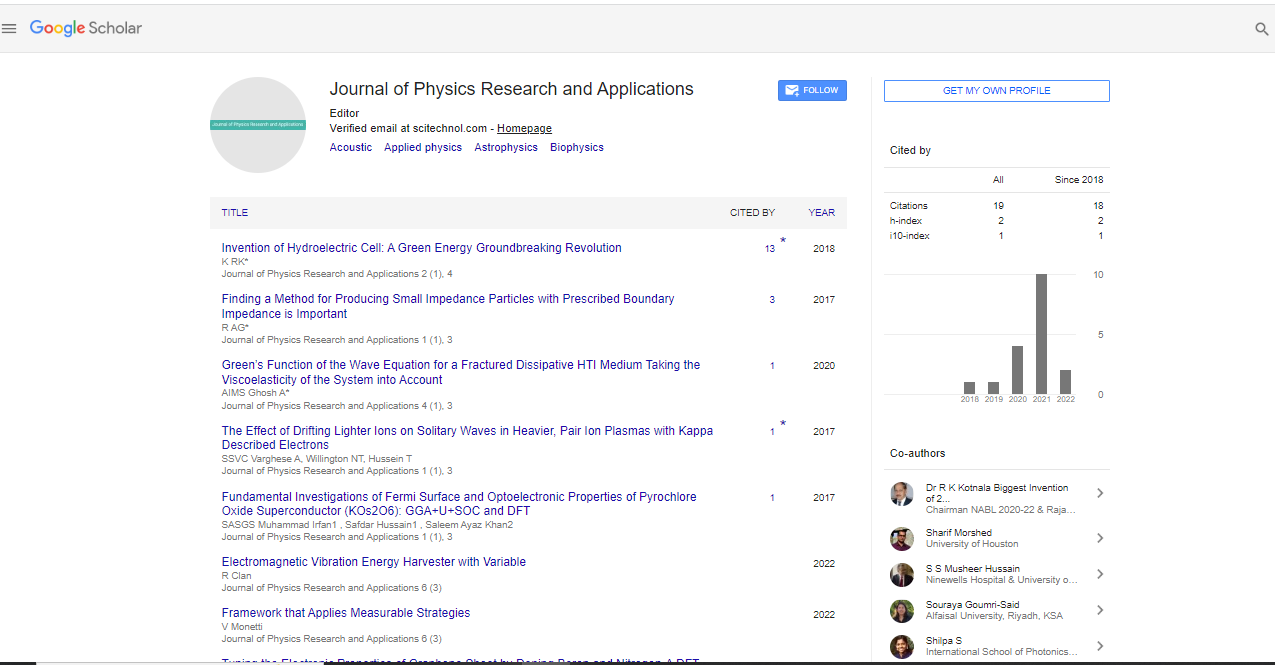Perspective, J Phys Res Appl Vol: 8 Issue: 3
Magnetic Resonance Imaging: The Electromagnetic Revolution in Medicine
Stephen Diego*
1Department of Physics and Astronomy, University of Tennessee, Knoxville, USA
*Corresponding Author: Stephen Diego,
Department of Physics & Astronomy,
University of Tennessee, Knoxville, USA
E-mail: stephen@dei.org
Received: 26 August, 2024, Manuscript No. JPRA-24-151992;
Editor assigned: 28 August, 2024, PreQC No. JPRA-24-151992 (PQ);
Reviewed: 11 September, 2024, QC No. JPRA-24-151992;
Revised: 18 September, 2024, Manuscript No. JPRA-24-151992 (R);
Published: 25 September, 2024, DOI: 10.4172/JPRA.1000116.
Citation: Diego S (2024) Magnetic Resonance Imaging: The Electromagnetic Revolution in Medicine. J Phys Res Appl 8:3.
Description
Magnetic Resonance Imaging (MRI) stands as one of the most significant advancements in medical imaging technology, revolutionizing the diagnostic methods and monitoring various health conditions. Since its introduction in the 1980s, MRI has become an indispensable tool in medical practice, enabling detailed visualization of internal structures without the need for invasive procedures or ionizing radiation. MRI works on the principles of electromagnetism, which allow for the non-invasive observation of soft tissues, making it particularly valuable in neurology, oncology and musculoskeletal medicine.
MRI depends on the principles of Nuclear Magnetic Resonance (NMR), which occur when atomic nuclei are exposed to a strong magnetic field and Radiofrequency (RF) radiation. The most commonly imaged nuclei in MRI are hydrogen nuclei (protons) found in water and fat, which are abundant in the human body. The MRI process begins with the patient being placed inside a powerful magnet, typically ranging from 1.5 tesla to 3.0 tesla. This magnetic field causes the protons in the body's tissues to align with the magnetic field. When an RF pulse is applied, the protons absorb energy and are temporarily knocked out of alignment. Once the RF pulse is turned off, the protons gradually return to their original alignment, releasing the absorbed energy in the process. This emitted energy is detected by the MRI scanner and converted into images. The varying rates at which different tissues return to equilibrium create contrast in the images. For example, fat returns to its original state more quickly than water, allowing for the differentiation of various tissues. Advanced imaging techniques, such as functional MRI (fMRI) and Diffusion-Weighted Imaging (DWI), have expanded the capabilities of MRI beyond anatomical imaging to assess brain activity and tissue integrity.
MRI's non-invasive nature and superior soft tissue contrast have led to its widespread application in various medical fields. MRI is important in diagnosing neurological disorders, including brain tumors, multiple sclerosis, strokes and neurodegenerative diseases like Alzheimer's. FMRI is invaluable for mapping brain function by detecting changes in blood flow associated with neural activity.
MRI plays an essential role in cancer detection, staging and monitoring treatment response. Its ability to provide high-resolution images of tumors helps in planning surgical interventions and radiation therapy. MRI is used for assessing soft tissue injuries, such as ligament tears, cartilage damage and muscle strains. Its detailed visualization of joint structures aids in accurate diagnosis and treatment planning. Cardiac MRI is utilized to evaluate heart anatomy and function, detect myocardial infarctions and assess cardiac conditions like hypertrophic cardiomyopathy and congenital heart defects. MRI is particularly beneficial in pediatric imaging due to its lack of ionizing radiation, making it a safer option for young patients.
The advantages of MRI over other imaging modalities, such as computed tomography (CT) and X-rays, are significant. MRI does not use ionizing radiation, reducing the risk of radiation-related complications, particularly in sensitive populations like children and pregnant women. MRI provides exceptional contrast between different types of soft tissues, allowing for accurate diagnosis of a wide range of conditions. Advanced MRI techniques enable the assessment of physiological processes, such as blood flow and metabolic activity, providing insights into the functional status of organs. MRI can produce images in multiple planes (sagittal, coronal and axial) without repositioning the patient, enhancing diagnostic accuracy. Patients with certain metallic implants, such as pacemakers or some types of orthopedic devices, may not be eligible for MRI due to safety concerns related to the strong magnetic field. MRI will undoubtedly play an essential role in shaping the future of medical imaging, for improved diagnostics and treatment strategies in healthcare.
 Spanish
Spanish  Chinese
Chinese  Russian
Russian  German
German  French
French  Japanese
Japanese  Portuguese
Portuguese  Hindi
Hindi 
